Investigation of In-Cylinder Steam Injection in a Turbocharged Diesel Engine for Waste Heat Recovery and NOx Emission Control
Abstract
:1. Introduction
2. Simulation Model
2.1. Engine Model Description
2.2. NOx Formation Kinetic Model
2.3. In-Cylinder Steam Injection Subsystem
3. Engine Model Validation
4. Results and Discussion
4.1. The Limits of Maximum Steam Mass and Temperature
4.2. The Impact of Steam Injection Mass
4.3. The Impact of Steam Injection Temperature
4.4. The Impact of Steam Injection Timing
4.5. Optimal Steam Injection Mass at Different Engine Speeds
5. Conclusions
- (1)
- The in-cylinder steam injection method can improve engine performance significantly at all engine speeds. This is because maximum in-cylinder pressure increases significantly as the working fluids in the cylinder increase after steam injection. Therefore, engine torque increases and BSFC decreases. When the steam injection timing is −30°, steam injection temperature is 550 K and steam injection pressure is 50 bar; with optimal steam injection mass, the maximum in-cylinder pressure increases by 9.3–12.7% across all engine speeds. As a result, engine torque increases by 9.5–10.9% and BSFC decreases by 8.6~9.9%.
- (2)
- With optimal steam injection mass, 83.4–91.8% reductions of NOx emissions are obtained at different engine speeds. The remarkable reduction is due to the fact that steam injection decreases maximum in-cylinder temperature and O2 concentration. The peak in-cylinder temperatures at different engine speeds are reduced by 11.2–13.9%.
- (3)
- Steam injection mass and injection timing are the key parameters that greatly influence engine performance and NOx emissions. As steam injection mass increases and injection timing slows down, engine performance is further improved and NOx emissions are lower. However, the steam injection mass is restricted by the minimum temperature difference and the exhaust temperature at the heat exchanger outlet . Besides, the injection timing is restricted by the in-cylinder pressure.
- (4)
- Steam injection temperature weakly affects engine performance. This is because the enthalpy of steam changes slightly as the steam injection temperature increases. Therefore, in-cylinder pressure and temperature are slightly impacted by the steam injection temperature. The changes of engine torque and BSFC are both within 0.4% when steam injection temperature increases from 450 K to 600 K. However, NOx emission is very sensitive to the change of in-cylinder temperature. NOx emissions increase by 17.3%, when the steam injection temperature increases from 450 K to 600 K.
Acknowledgments
Author Contributions
Conflicts of Interest
Nomenclature
| Latin symbols | |
| A | area (m2) |
| Cm | mean velocity (m/s) |
| cp | constant pressure specific heat (J/(kg·K)) |
| cv | constant volume specific heat (J/(kg·K)) |
| D | diameter of cylinder (m) |
| h | enthalpy (J/kg) |
| k | rate constant (cm3/(mol·s)) |
| l | length of connecting rod (m) |
| M | molar mass (kg/mol) |
| mass flow rate (kg/s) | |
| m | mass (kg) |
| p | pressure (Pa) |
| P | power (kW) |
| Q | heat quantity (J) |
| Rg | gas constant (J/(kg·K)) |
| r | radius of crank (m) |
| s | shape factor |
| T | temperature (K) |
| U | internal energy (J) |
| u | specific internal energy (J/kg) |
| V | stroke volume (m3) |
| v | specific volume (m3/kg) |
| Greek symbols | |
| coefficient | |
| specific heat ratio | |
| compression ratio | |
| efficiency | |
| ϕ | crank angle (°) |
| Acronyms | |
| BSFC | brake-specific fuel consumption |
| IVC | intake valve close |
| TDC | top dead center |
| Subscripts and superscripts | |
| 0–7 | locations in the engine systems |
| a | air |
| b | burn |
| e | exhaust |
| min | minimum |
| m | mixture |
| w | water or wall |
References
- Fu, J.; Liu, J.; Ren, C.; Wang, L.; Deng, B.; Xu, Z. An open steam power cycle used for IC engine exhaust gas energy recovery. Energy 2012, 44, 544–554. [Google Scholar] [CrossRef]
- Zhang, L.; Su, T.; Zhang, Y.; Ma, F.; Yin, J.; Feng, Y. Numerical Investigation of the Effects of Split Injection Strategies on Combustion and Emission in an Opposed-Piston, Opposed-Cylinder (OPOC) Two-Stroke Diesel Engine. Energies 2017, 10, 684. [Google Scholar] [CrossRef]
- Andwari, A.M.; Pesiridis, A.; Esfahanian, V.; Salavati-Zadeh, A.; Karvountzis-Kontakiotis, A.; Muralidharan, V. A Comparative Study of the Effect of Turbocompounding and ORC Waste Heat Recovery Systems on the Performance of a Turbocharged Heavy-Duty Diesel Engine. Energies 2017, 10, 1087. [Google Scholar] [CrossRef]
- Feng, L.; Tian, J.; Long, W.; Gong, W.; Du, B.; Li, D.; Chen, L. Decreasing NOx of a Low-Speed Two-Stroke Marine Diesel Engine by Using In-Cylinder Emission Control Measures. Energies 2016, 9, 304. [Google Scholar] [CrossRef]
- Zamboni, G.; Moggia, S.; Capobianco, M. Effects of a Dual-Loop Exhaust Gas Recirculation System and Variable Nozzle Turbine Control on the Operating Parameters of an Automotive Diesel Engine. Energies 2017, 10, 47. [Google Scholar] [CrossRef]
- Latz, G.; Erlandsson, O.; Skare, T.; Contet, A.; Andersson, S.; Munch, K. Performance Analysis of a Reciprocating Piston Expander and a Plate Type Exhaust Gas Recirculation Boiler in a Water-Based Rankine Cycle for Heat Recovery from a Heavy Duty Diesel Engine. Energies 2016, 9, 495. [Google Scholar] [CrossRef]
- Altosole, M.; Benvenuto, G.; Campora, U.; Laviola, M.; Trucco, A. Waste Heat Recovery from Marine Gas Turbines and Diesel Engines. Energies 2017, 10, 718. [Google Scholar] [CrossRef]
- Song, H.; Quinton, K.S.; Peng, Z.; Zhao, H.; Ladommatos, N. Effects of Oxygen Content of Fuels on Combustion and Emissions of Diesel Engines. Energies 2016, 9, 28. [Google Scholar] [CrossRef]
- Tesfa, B.; Mishra, R.; Gu, F.; Ball, A.D. Water injection effects on the performance and emission characteristics of a CI engine operating with biodiesel. Renew. Energy 2012, 37, 333–344. [Google Scholar] [CrossRef]
- Tauzia, X.; Maiboom, A.; Shah, S.R. Experimental study of inlet manifold water injection on combustion and emissions of an automotive direct injection Diesel engine. Energy 2010, 35, 3628–3639. [Google Scholar] [CrossRef]
- Bozza, F.; De Bellis, V.; Teodosio, L. Potentials of cooled EGR and water injection for knock resistance and fuel consumption improvements of gasoline engines. Appl. Energy 2016, 169, 112–125. [Google Scholar] [CrossRef]
- Kim, J.; Park, H.; Bae, C.; Choi, M.; Kwak, Y. Effects of water direct injection on the torque enhancement and fuel consumption reduction of a gasoline engine under high-load conditions. Int. J. Engine Res. 2016, 17, 795–808. [Google Scholar] [CrossRef]
- Hoppe, F.; Thewes, M.; Baumgarten, H.; Dohmen, J. Water injection for gasoline engines: Potentials, challenges, and solutions. Int. J. Engine Res. 2016, 17, 86–96. [Google Scholar] [CrossRef]
- Wu, Z.-J.; Yu, X.; Fu, L.-Z.; Deng, J.; Hu, Z.-J.; Li, L.-G. A high efficiency oxyfuel internal combustion engine cycle with water direct injection for waste heat recovery. Energy 2014, 70, 110–120. [Google Scholar] [CrossRef]
- Wu, Z.-J.; Yu, X.; Fu, L.-Z.; Deng, J.; Li, L.-G. Experimental study of the effect of water injection on the cycle performance of an internal-combustion Rankine cycle engine. Proc. Inst. Mech. Eng. Part D J. Autom. Eng. 2014, 228, 580–588. [Google Scholar] [CrossRef]
- Conklin, J.C.; Szybist, J.P. A highly efficient six-stroke internal combustion engine cycle with water injection for in-cylinder exhaust heat recovery. Energy 2010, 35, 1658–1664. [Google Scholar] [CrossRef]
- Arabaci, E.; Icingur, Y.; Solmaz, H.; Uyumaz, A.; Yilmaz, E. Experimental investigation of the effects of direct water injection parameters on engine performance in a six-stroke engine. Energy Convers. Manag. 2015, 98, 89–97. [Google Scholar] [CrossRef]
- Parlak, A.; Ayhan, V.; Ust, Y.; Sahin, B.; Cesur, I.; Boru, B.; Kokkulunk, G. New method to reduce NOx emissions of diesel engines: Electronically controlled steam injection system. J. Energy Inst. 2012, 85, 135–139. [Google Scholar] [CrossRef]
- Cesur, I.; Parlak, A.; Ayhan, V.; Boru, B.; Gonca, G. The effects of electronic controlled steam injection on spark ignition engine. Appl. Therm. Eng. 2013, 55, 61–68. [Google Scholar] [CrossRef]
- Kokkulunk, G.; Gonca, G.; Ayhan, V.; Cesur, I.; Parlak, A. Theoretical and experimental investigation of diesel engine with steam injection system on performance and emission parameters. Appl. Therm. Eng. 2013, 54, 161–170. [Google Scholar] [CrossRef]
- Kokkulunk, G.; Parlak, A.; Ayhan, V.; Cesur, I.; Gonca, G.; Boru, B. Theoretical and experimental investigation of steam injected diesel engine with EGR. Energy 2014, 74, 331–339. [Google Scholar] [CrossRef]
- Gonca, G. Investigation of the effects of steam injection on performance and NO emissions of a diesel engine running with ethanol-diesel blend. Energy Convers. Manag. 2014, 77, 450–457. [Google Scholar] [CrossRef]
- Gonca, G.; Sahin, B. Simulation of performance and nitrogen oxide formation of a hydrogen-enriched diesel engine with the steam injection method. Therm. Sci. 2015, 19, 1985–1994. [Google Scholar] [CrossRef]
- Gonca, G. Investigation of the influences of steam injection on the equilibrium combustion products and thermodynamic properties of bio fuels (biodiesels and alcohols). Fuel 2015, 144, 244–258. [Google Scholar] [CrossRef]
- Gonca, G.; Sahin, B.; Parlak, A.; Ust, Y.; Ayhan, V.; Cesur, I.; Boru, B. The effects of steam injection on the performance and emission parameters of a Miller cycle diesel engine. Energy 2014, 78, 266–275. [Google Scholar] [CrossRef]
- Gonca, G.; Sahin, B.; Ust, Y.; Parlak, A.; Safa, A. Comparison of steam injected diesel engine and Miller cycled diesel engine by using two zone combustion model. J. Energy Inst. 2015, 88, 43–52. [Google Scholar] [CrossRef]
- Gonca, G.; Sahin, B. The influences of the engine design and operating parameters on the performance of a turbocharged and steam injected diesel engine running with the Miller cycle. Appl. Math. Model. 2016, 40, 3764–3782. [Google Scholar] [CrossRef]
- Gonca, G.; Sahin, B. Effect of turbo charging and steam injection methods on the performance of a Miller cycle diesel engine (MCDE). Appl. Therm. Eng. 2017, 118, 138–146. [Google Scholar] [CrossRef]
- Gonca, G.; Sahin, B.; Parlak, A.; Ayhan, V.; Cesur, I.; Koksal, S. Investigation of the effects of the steam injection method (SIM) on the performance and emission formation of a turbocharged and Miller cycle diesel engine (MCDE). Energy 2017, 119, 926–937. [Google Scholar] [CrossRef]
- Fu, J.; Liu, J.; Wang, Y.; Deng, B.; Yang, Y.; Feng, R.; Yang, J. A comparative study on various turbocharging approaches based on IC engine exhaust gas energy recovery. Appl. Energy 2014, 113, 248–257. [Google Scholar] [CrossRef]
- Fu, J.; Liu, J.; Yang, Y.; Ren, C.; Zhu, G. A new approach for exhaust energy recovery of internal combustion engine: Steam turbocharging. Appl. Therm. Eng. 2013, 52, 150–159. [Google Scholar] [CrossRef]
- Fu, J.; Liu, J.; Deng, B.; Feng, R.; Yang, J.; Zhou, F.; Zhao, X. An approach for exhaust gas energy recovery of internal combustion engine: Steam-assisted turbocharging. Energy Convers. Manag. 2014, 85, 234–244. [Google Scholar] [CrossRef]
- Zhu, S.; Deng, K.; Qu, S. Thermodynamic analysis of an in-cylinder waste heat recovery system for internal combustion engines. Energy 2014, 67, 548–556. [Google Scholar] [CrossRef]
- Zhu, S.; Liu, S.; Qu, S.; Deng, K. Thermodynamic and experimental researches on matching strategies of the pre-turbine steam injection and the Miller cycle applied on a turbocharged diesel engine. Energy 2017, 140, 488–505. [Google Scholar] [CrossRef]
- Zhao, R.; Li, W.; Zhuge, W.; Zhang, Y.; Yin, Y. Numerical study on steam injection in a turbocompound diesel engine for waste heat recovery. Appl. Energy 2017, 185, 506–518. [Google Scholar] [CrossRef]
- Rakopoulos, C.D.; Dimaratos, A.M.; Giakoumis, E.G.; Rakopoulos, D.C. Exhaust emissions estimation during transient turbocharged diesel engine operation using a two-zone combustion model. Int. J. Veh. Des. 2009, 49, 125–149. [Google Scholar] [CrossRef]
- NIST Standard Reference Database 23; REFPROP Version 7.1; The U.S. Secretary of Commerce: Washington, DC, USA, 2003.
- Ghouma, I.; Jeguirim, M.; Sager, U.; Limousy, L.; Bennici, S.; Daeuber, E.; Asbach, C.; Ligotski, R.; Schmidt, F.; Ouederni, A. The Potential of Activated Carbon Made of Agro-Industrial Residues in NOx Immissions Abatement. Energies 2017, 10, 1508. [Google Scholar] [CrossRef]




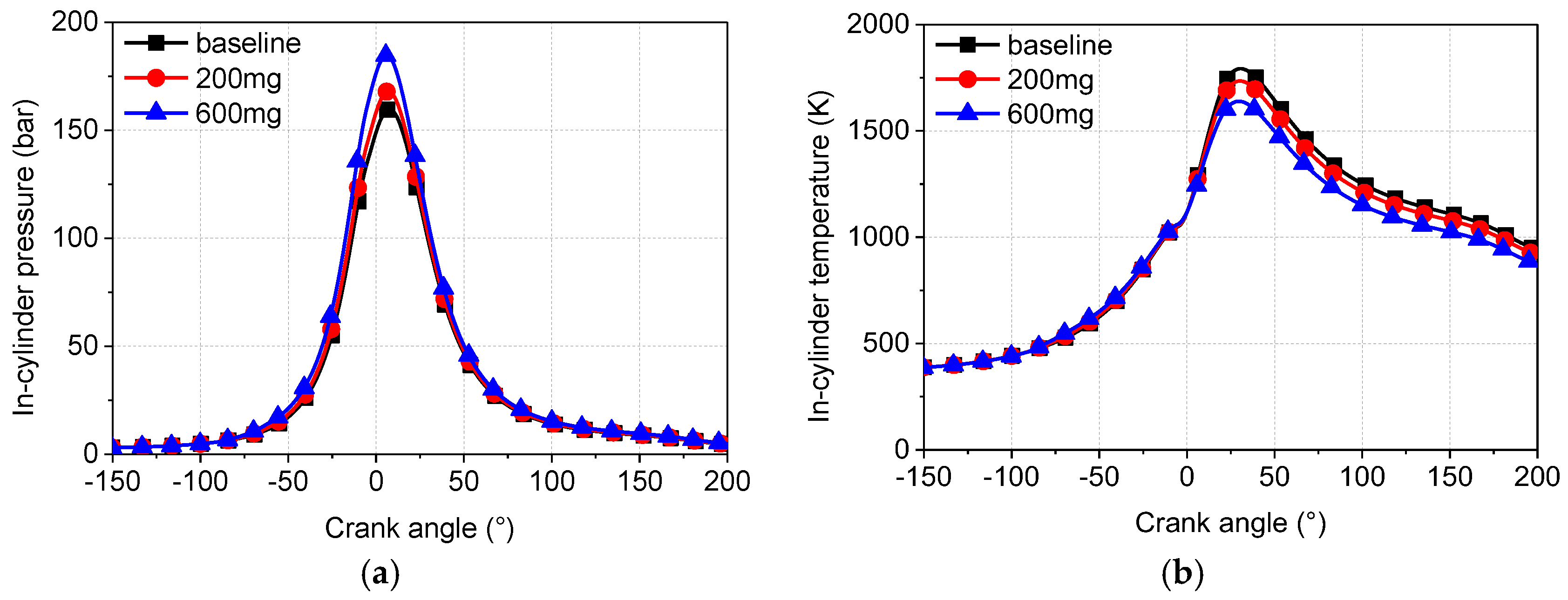

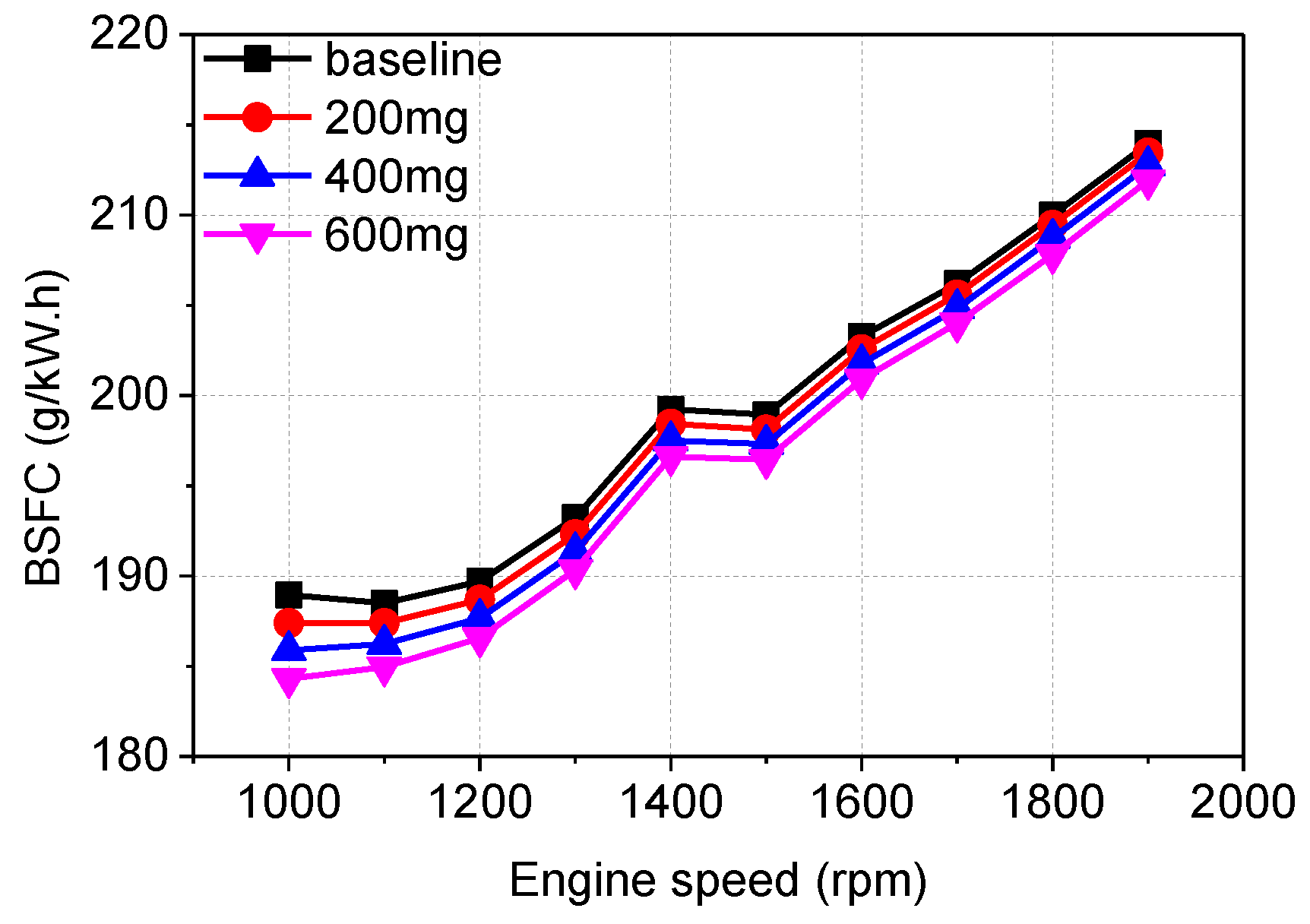

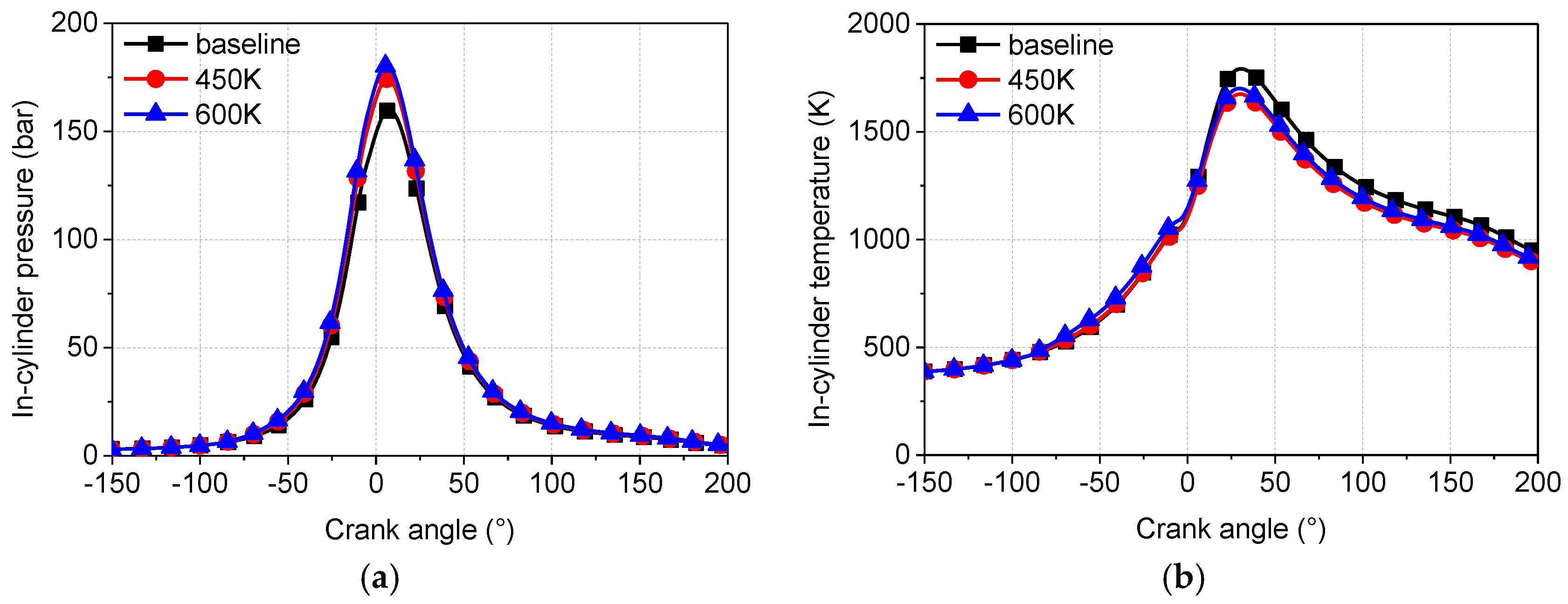

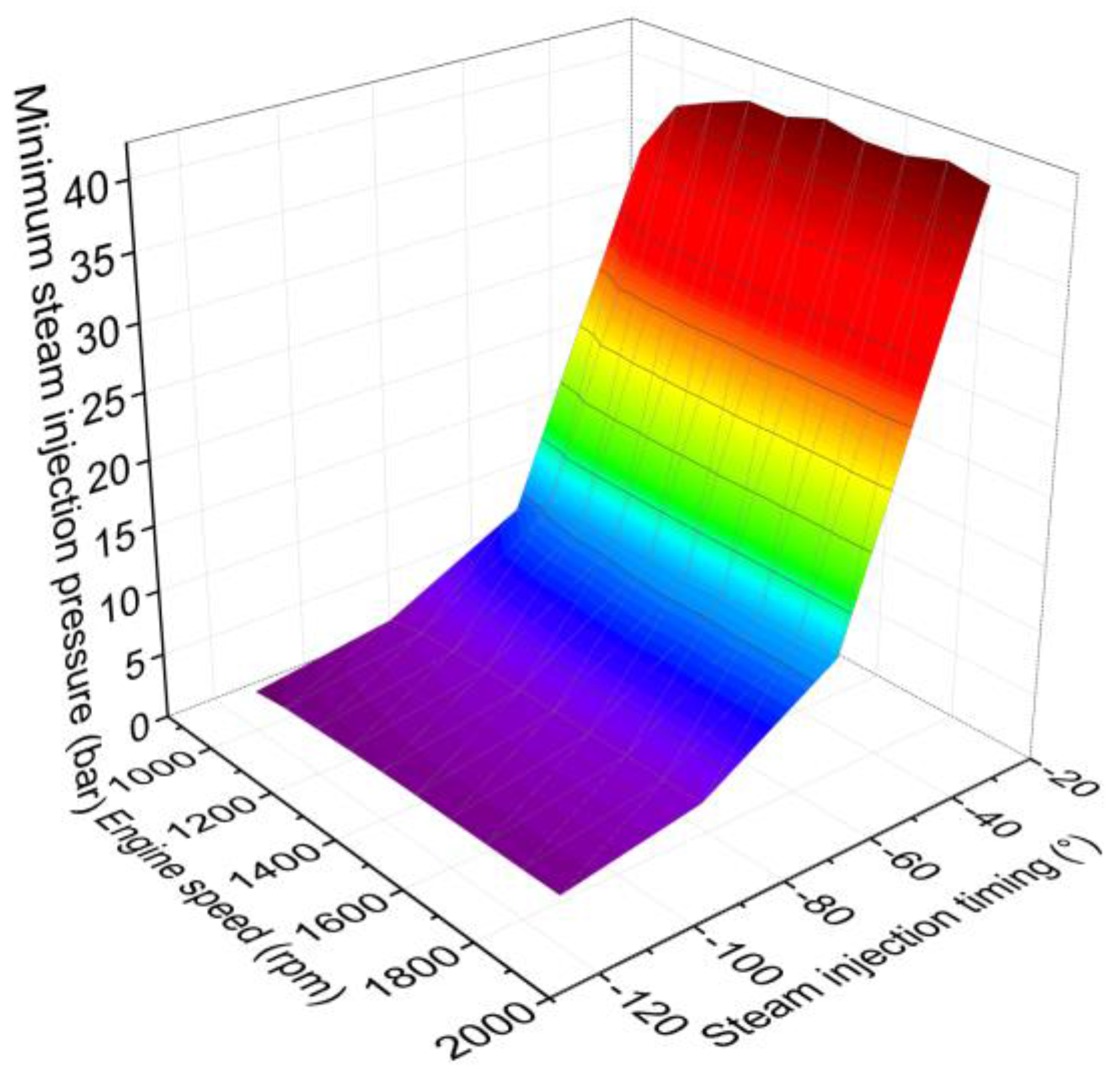
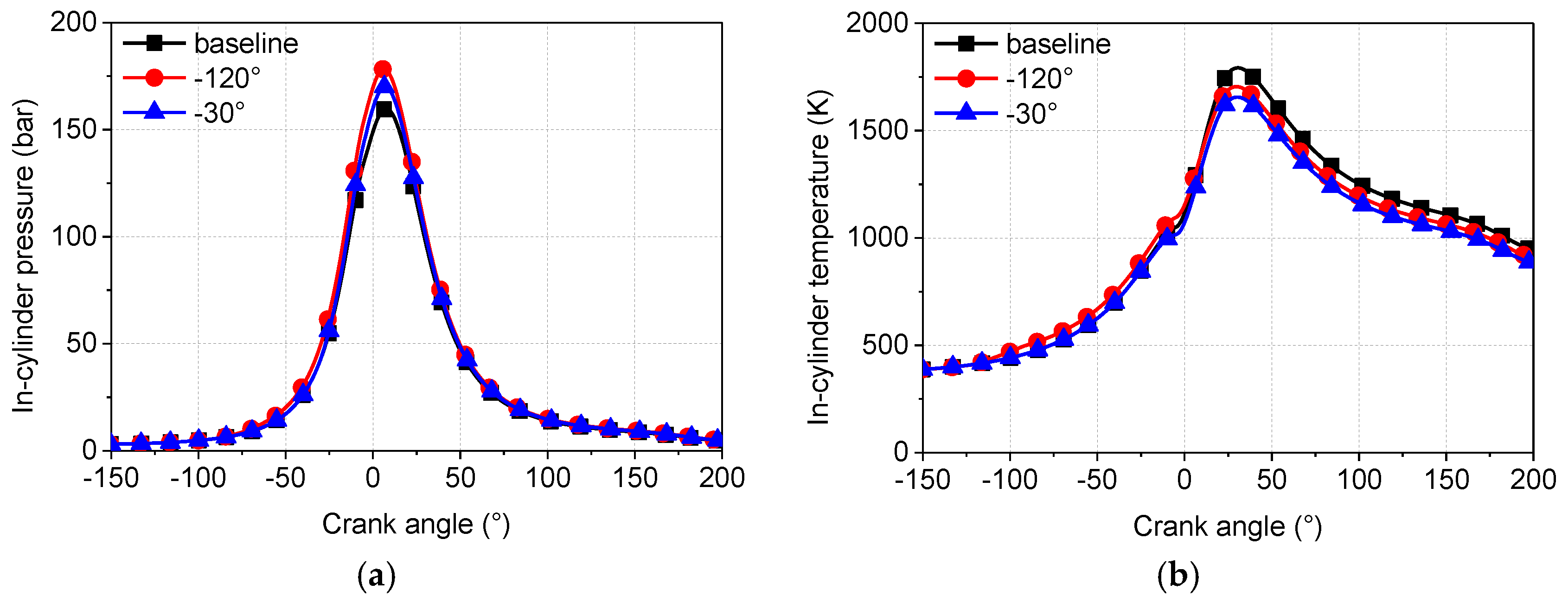
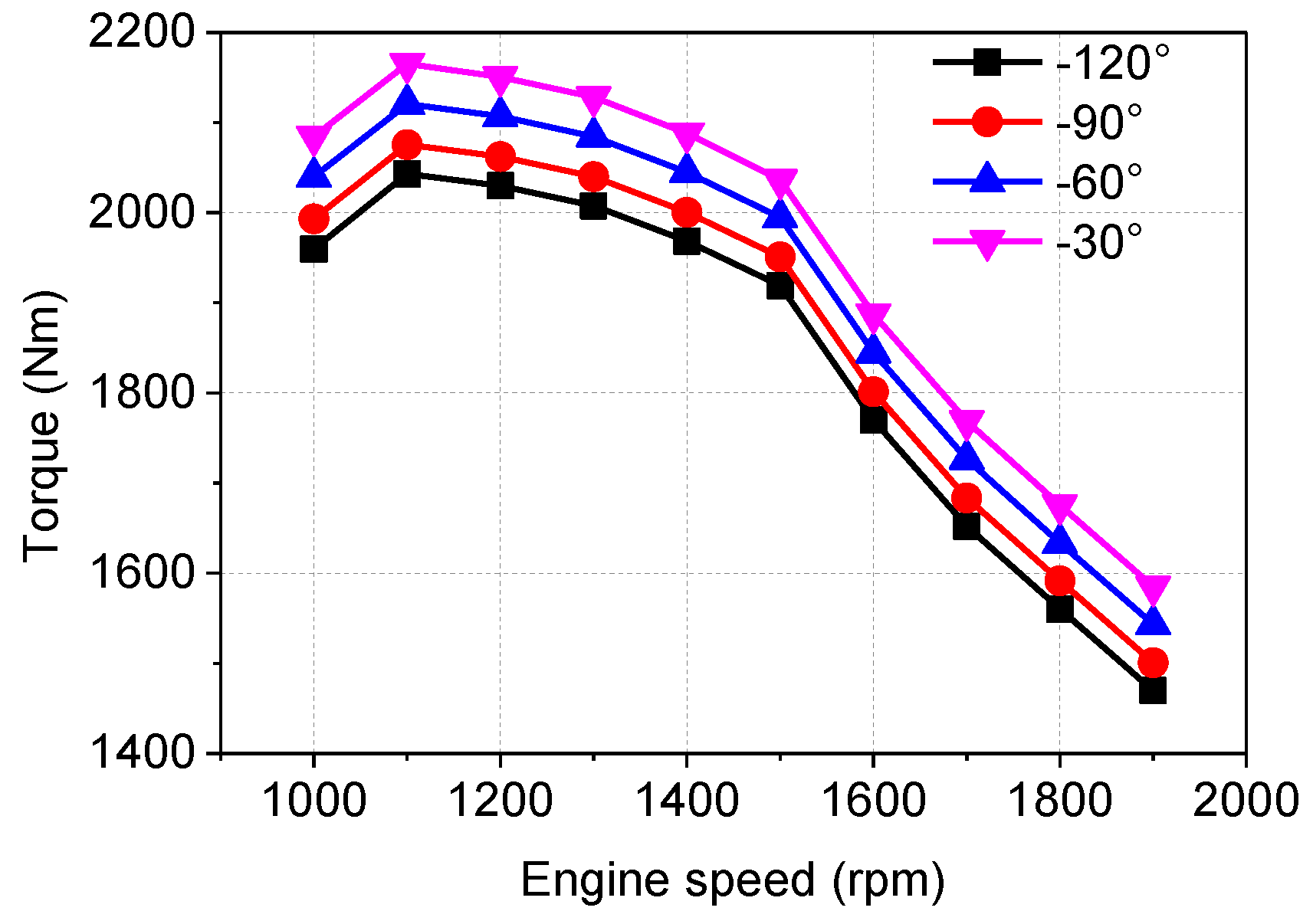
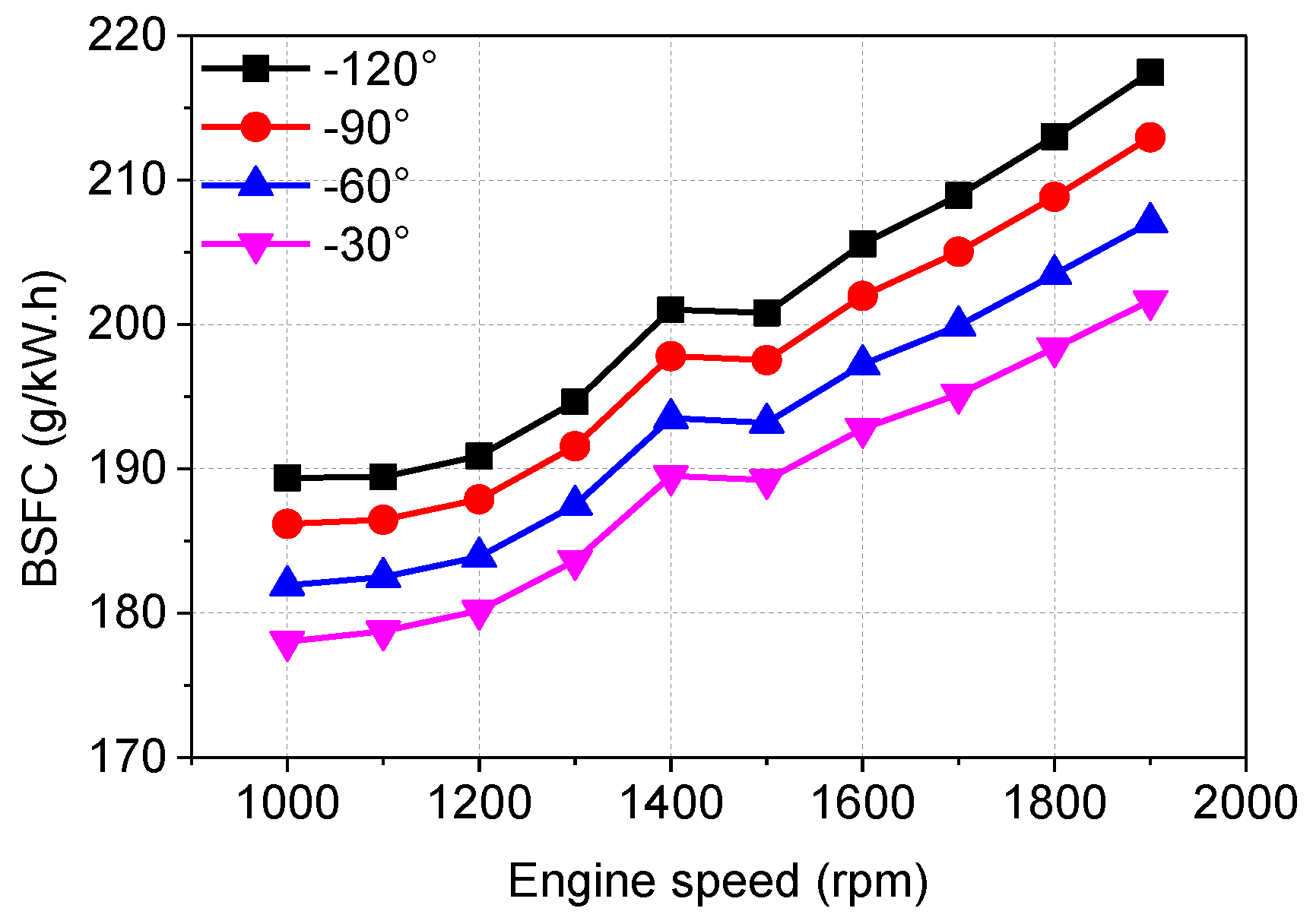
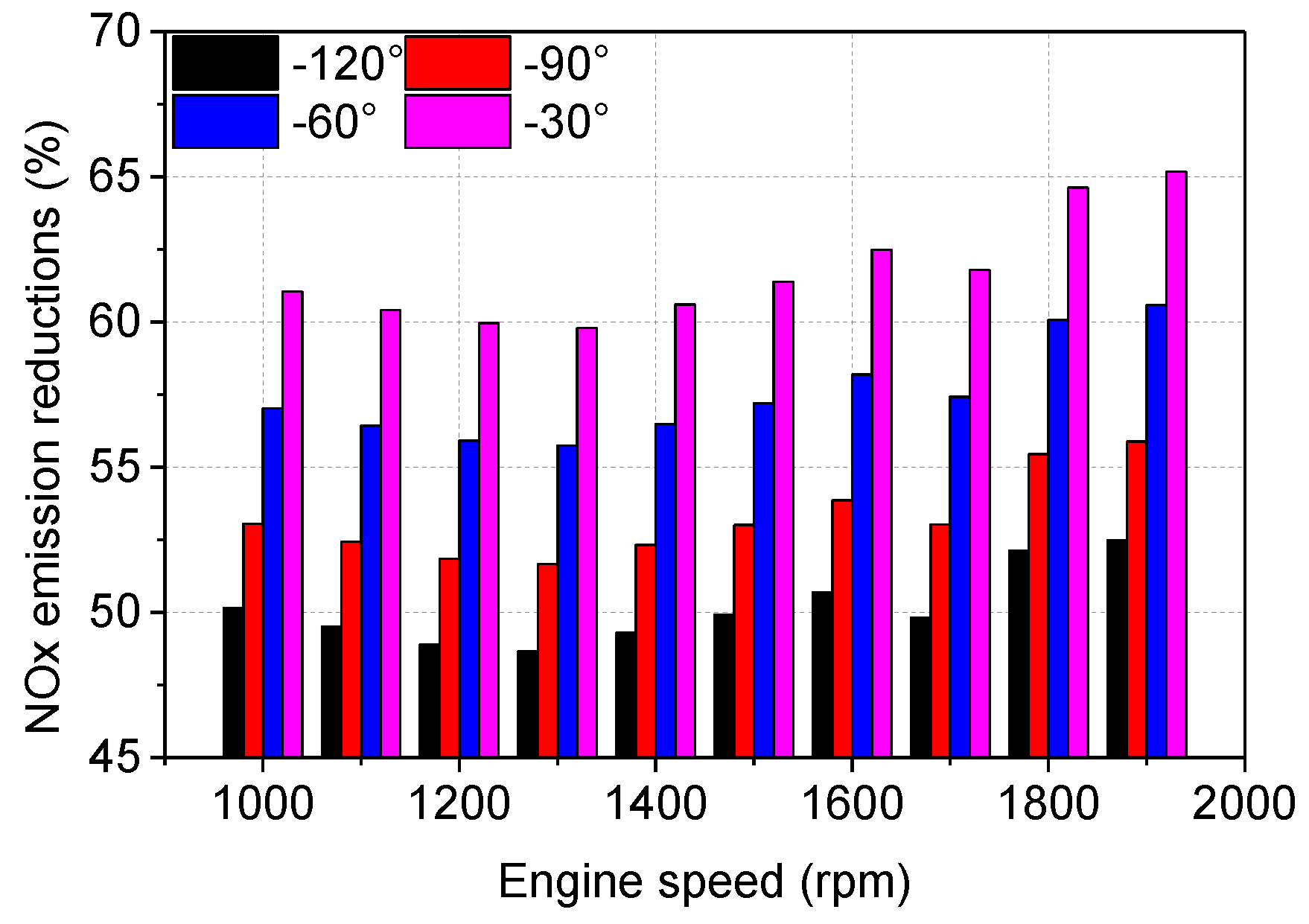
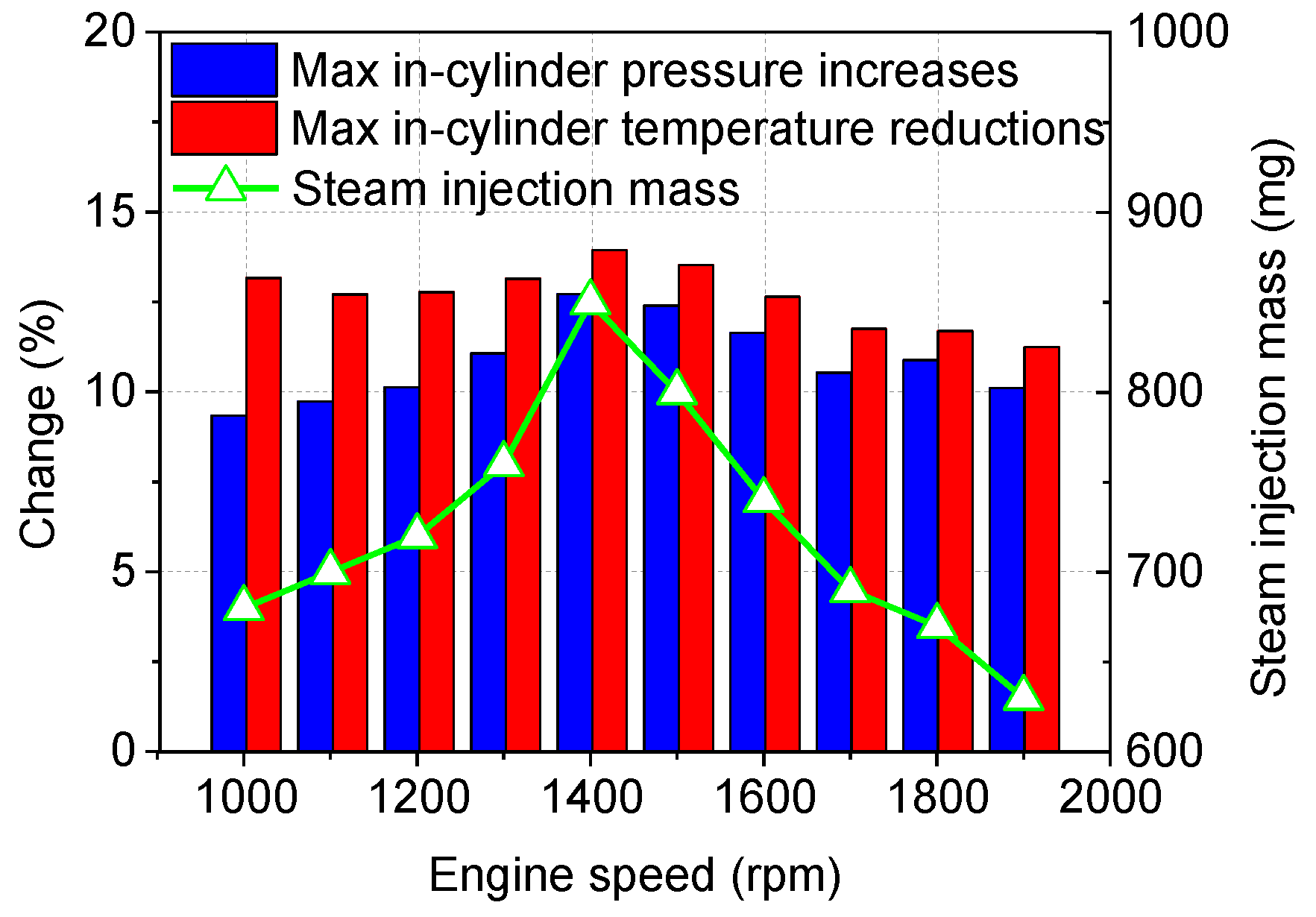
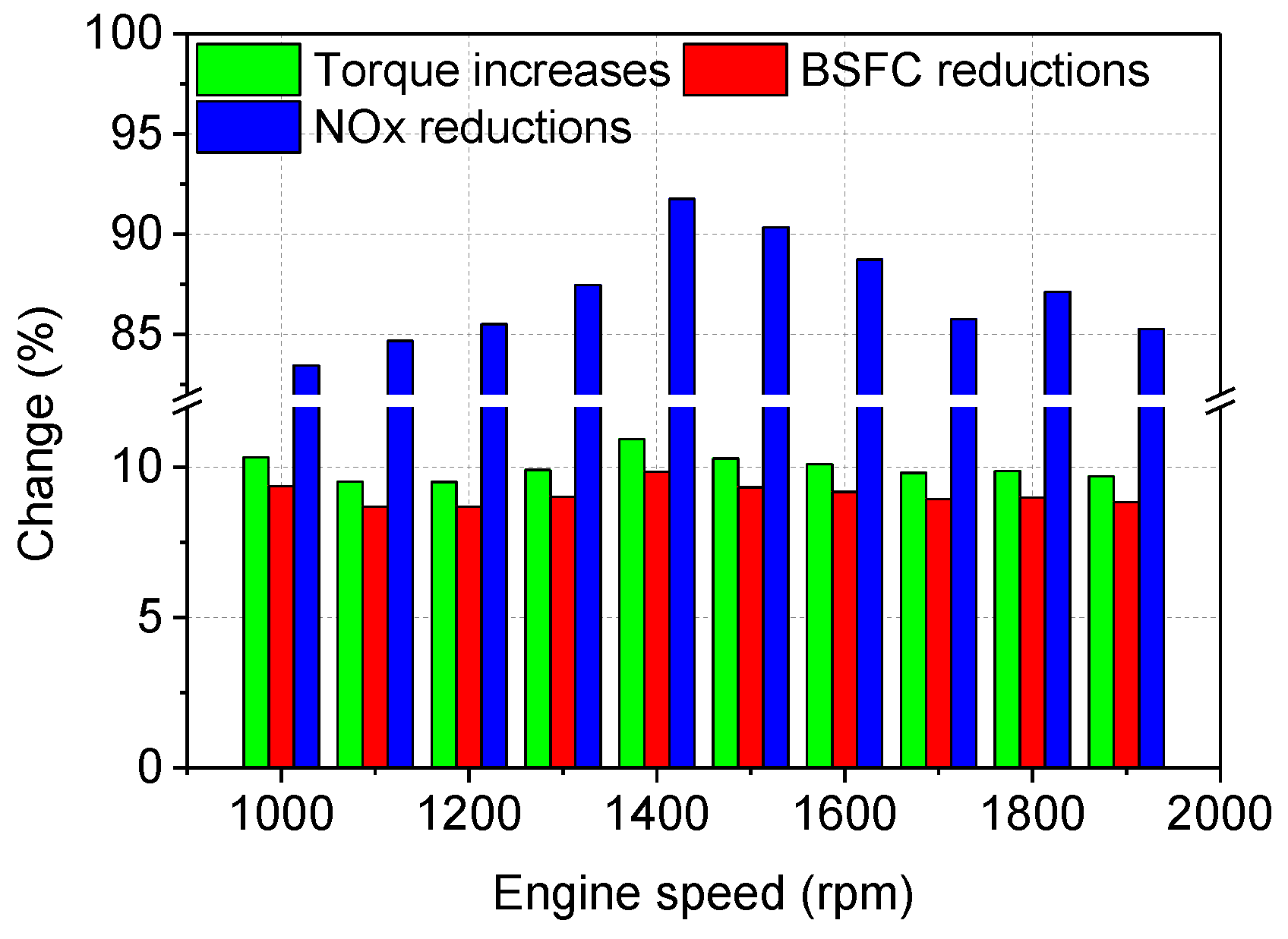
| Parameter | Value |
|---|---|
| Number of cylinders | 6 |
| Displacement | 11 L |
| Compression ratio | 16.4 |
| Bore | 123 mm |
| Stroke | 156 mm |
| Maximum power | 298 kW@1900 rpm |
| Maximum torque | 1825 Nm@1200 rpm |
| Emission standards | Euro IV |
| Parameter | Measurement Range | Systematic Error |
|---|---|---|
| Engine torque | 0–2800 Nm | ±5.6 Nm |
| Engine speed | 0–5000 rpm | ±1 rpm |
| NOx emissions | 0–5000 ppm | ±4% of measured value |
| Fuel consumption | 5–150 kg/h | ±0.2% of measured value |
| Exhaust temperature | 0–980 °C | ±2.2 °C |
© 2018 by the authors. Licensee MDPI, Basel, Switzerland. This article is an open access article distributed under the terms and conditions of the Creative Commons Attribution (CC BY) license (http://creativecommons.org/licenses/by/4.0/).
Share and Cite
Zhang, Z.; Li, L. Investigation of In-Cylinder Steam Injection in a Turbocharged Diesel Engine for Waste Heat Recovery and NOx Emission Control. Energies 2018, 11, 936. https://doi.org/10.3390/en11040936
Zhang Z, Li L. Investigation of In-Cylinder Steam Injection in a Turbocharged Diesel Engine for Waste Heat Recovery and NOx Emission Control. Energies. 2018; 11(4):936. https://doi.org/10.3390/en11040936
Chicago/Turabian StyleZhang, Zhongbo, and Lifu Li. 2018. "Investigation of In-Cylinder Steam Injection in a Turbocharged Diesel Engine for Waste Heat Recovery and NOx Emission Control" Energies 11, no. 4: 936. https://doi.org/10.3390/en11040936





